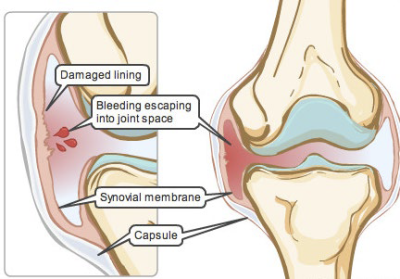This leaflet answers common questions about radioactive synovectomies. If you would like further information or have any worries, please do not hesitate to ask your specialist haemophilia team.
In all cases, your healthcare professional will explain the procedure to you and answer any questions you may have. In most cases it will be possible for a friend or relative to accompany you for all or part of the procedure. Please ask your specialist clinicians.

What is a radioactive synovectomy?
Most joints in the body contain a lining called the synovium. In a normal healthy joint the synovium:
- Provides lubrication for joint movement
- Provides nutrition for the cartilage in the joint
- Helps to remove waste material from day-to-day use of the joint.
To do this well, the synovium has a good blood supply. This can mean that in haemophilia, if the lining gets caught it can release blood into the joint (see picture below).

Is it effective?
Clinical research and feedback from many patients having the procedure has been positive. They show a reduction in bleeding without additional factor concentrate and improvements in pain and joint function, even in joints with haemophilic arthritis.
Risks and side effects
There may be some discomfort initially during the injection, but pain should not persist for long after this. Taking regular pain killers will help during the first few days. It is important to report any discomfort beyond this (including skin irritation at the needle site) to your haemophilia team.
How to find us
Katharine Dormandy haemophilia centre and thrombosis unit
Ground Floor
Royal Free Hospital
Pond Street
London
NW3 2QG
 Translate
Translate